34 years. At least in my case.
I applied to MIT in 1978, intending to major in mechanical engineering so I could work for NASA. They turned me down, as did CalTech.
They made the right decision. Based on my poor showing at Northwestern, I didn't have the necessary academic discipline. I should have followed the example of my roommate, who completed a 5-year accelerated BS/MS in biochemistry before getting his PhD at Stanford.
I eventually learned that discipline (see my simple recipe for how to crush calculus), but by then I was off on my software career and going to MIT was a distant dream.
Well, I finally made it. Monday I started a new job at Akamai Technologies in Cambridge, MA, a block from MIT. Ok, so I'm not technically at MIT, but I'm as close as you can get without actually being on campus, working at a company founded by an MIT algorithms professor and one of his grad students. I'm in the zone: The MIT Zone.
Walking around the area makes your skin tingle. You see big high-tech and bio-tech names on all the buildings, Google, Microsoft, VMware, Biogen Idec, Amgen, many more. The place vibrates with intensity, and it's not just the subway running underneath. Some of the finest minds in the world are concentrated here, doing things that affect the whole world.
You may have noticed a dearth of woodworking posts here over the last two months. That's because I spent the first month preparing for the interview, studying books and papers. Then I spent a couple weeks just decompressing; even under the best of circumstances, changing jobs is stressful. The last two weeks I've just started to get back into stride.
I wasn't looking for a new job, but this is another LinkedIn success story. An Akamai recruiter contacted me via LinkedIn, and as I started looking into their technical publications, I realized this was really cool.
According to Akamai's website, they serve up to 30% of all web traffic; they have a distributed network of over 119,000 servers spread all over the globe, handling over 2 trillion daily Internet interactions. That's over 23 million per second.
Companies like Apple and Facebook are the high-profile rock stars of the Internet, but Akamai is the group of session musicians everyone relies on, the low-profile professionals working behind the scenes, like Glen Campbell and The Wrecking Crew. Their list of representative customers is full of big names.
Founder Tom Leighton of MIT's CSAIL, Computer Science and Artificial Intelligence Laboratory, got to thinking about the technology that became Akamai when fellow MIT professor Tim Berners-Lee talked to him about what was slowing down Internet traffic.
Yeah, Tim-the-inventor-of-the-World-Wide-Web, that Tim. Leighton and co-founder Danny Lewin eventually realized the only way to put this technology into practice was to start their own company.
Who wouldn't want to work at a place like this, with people like this, on problems at this scale? I jumped at the chance. The people I worked with at Dell/EqualLogic were all great people, working on a great product at a great company, but this really hooked me. Perhaps you can tell I'm excited to be working here!
They've seen dark times. The worst was when Danny Lewin was killed on September 11, 2001, aboard American Airlines Flight 11. A small park next to the Akamai building honors his memory.
On the business side, Akamai was one of those companies whose stock shot to stratospheric levels during the tech bubble, only to lose nearly all its value when the bubble burst and many of their customers went out of business. But the company survived, and that resilience is another thing that attracted me.
Bostonians tell you it's the hub of the universe. I'm starting to believe it. The inexorable pull of its gravity well has drawn in not only me, but also two of my roommates from distant places and times. That college roommate from 34 years ago in Chicago works five blocks away. I just recently discovered that my roommate from when I worked at Texas Instruments in Sherman, Texas 30 years ago has been in the Boston area for 17 years.
The commute between Cambridge and the suburbs does mean I'll have less time for woodworking during the week. At least I can do it riding the train and reading a book instead of fighting traffic for an hour or more. The commuter trains even have Wi-Fi, so I can check email or work on the blog.
I always said I would never work in Boston (yep, never say never), and the traffic was the reason. But I live just a 15-minute walk from a commuter rail station, and Akamai is a block from the subway. The monthly rail pass costs just a little more than a month's worth of gas, and I won't be putting a thousand miles a month on my van, so I won't have to buy a new one before the kids finish college. I can be green while saving green.
Another perk is that I'm just a short subway trip from Boston Harbor. In the Spring I can get a weekday membership at Boston Sailing Center and take a J-24 out after work, bringing it back in after dark. I'm sure I can find willing hands to man the sheets and halyards; if not, I can single-hand a boat easily enough. Night sailing along the waterfront is glorious.
Quick update: commenter TJIC also pointed out I'm just a short subway trip from North Bennet Street School in the North End! I can take some short courses at one of the finest woodworking schools in the country.
But wait, there's more! My wife says you can't make this stuff up.
I first heard about Akamai when I worked at a startup named Verivue, building video streaming servers. There were some parallels between what we were trying to do and what Akamai was doing with their content distribution service. Unfortunately, it didn't work out; Verivue shifted technical strategy and laid me off with half the rest of the company two years ago today.
Two days ago, Akamai publicly announced they have acquired Verivue. How's that for amazing? Just goes to show how small the high tech networking community is. I said back then I would be happy to work with those folks again, because I like and respect them, despite getting laid off. While unpleasant, that wasn't personal. If it ain't happenin', it ain't happenin', so move on to something that is.
I don't know who will end up doing what where, since the company Akamai bought is different from the one I left, having completed their technology shift. But if I run into any of them in the hall, I'll shake their hands, we can all roll our eyes at life and then go build cool stuff.
So begins a new adventure! By the way, if you're interested, they're still looking for more people.
Disclaimer: The postings on this site are my own and do not express the positions, strategies, or opinions of Akamai or any other company mentioned here.
Friday, December 7, 2012
Sunday, December 2, 2012
Lie-Nielsen Hand Tool Event At FIM 2012

Phil Lowe in front of the Lie-Nielsen tool display.
This past Friday and Saturday I again participated in the Lie-Nielsen Hand Tool Event at Phil Lowe's Furniture Institute of Massachusetts, representing the Society of American Period Furniture Makers. Like last year, this was a great opportunity to see some great woodworkers at work and tell people about SAPFM membership.
Phil is one of my woodworking heroes. While I've never taken any of his classes, I've learned a tremendous amount over the years from his articles and videos. Formerly head of the cabinetmaking and furniture program at North Bennet St. School, he's superbly skilled and enjoys passing the craft on to others.

Peter Follansbee carving details in a chest stile.
Peter Follansbee was busy working on a full-sized chest of drawers made of riven oak. You can read more about this chest on his blog. I had him autograph my copy of his new book co-authored with Jennie Alexander, Make a Joint Stool From a Tree.
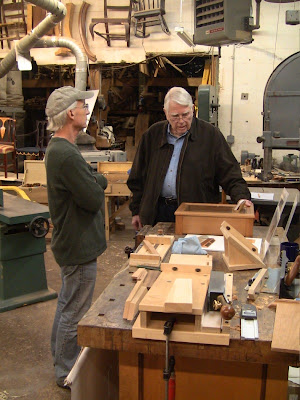
Tico Vogt, left, talking to SAPFM member Bruce Wedlock.
Tico Vogt was promoting his Super Chute 2.0 shooting board, demonstrating how precisely he could fit a piece to an opening.
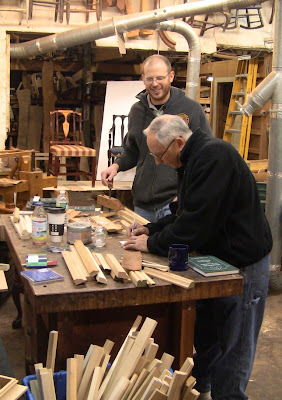
Matt Bickford, rear, talking to blog reader Albert Oullette.
Matt Bickford was demonstrating his gorgeous wooden moulding planes and selling copies of his new book, Mouldings in Practice.
One of the new people I met was John Cameron, an instructor at FIM. I had seen some of his work on display at Topsfield Fair. In addition to woodworking, he also teaches metal engraving. His engravings are beautiful, amazingly detailed small pictures of line art, lettering, stippling, and deep chisel carving. He uses these for custom furniture hardware and decorations.

John Cameron engraving a small metal plate.
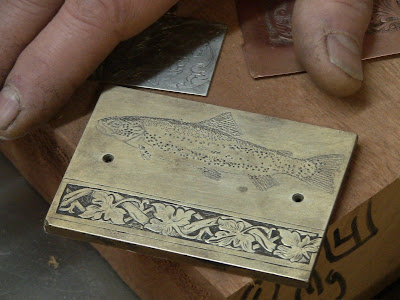
I loved John's gorgeous stippled trout.
Another new woodworker I met was Roger Benton, working as LN event staff. In addition to making custom furniture, he runs a lumber mill that uses only fallen wood from the New York City area. This is the true essence of Harvesting Urban Timber
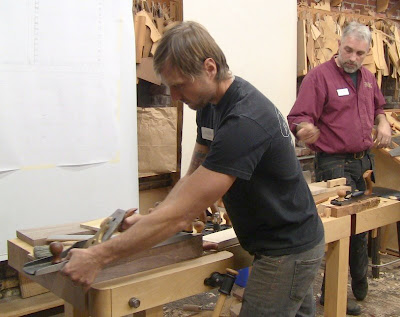
LN event staff Roger Benton, left, and Deneb Puchalski demonstrating hand plane use.
Since a couple of people had to cancel for the event, I had extra space, so I made like the Three Stooges and spread out. I brought my portable workbench to use as an auxiliary tool and display space. I set up my always-popular portable sharpening station and SAPFM brochures on it, along with a variety of tools I was using.
That helped keep the main workbench from getting completely overwhelmed with stuff. When not talking to people, I continued working on the cherry frame and panel door I had started at the previous Hand Tool Event at Connecticut Valley School of Woodworking.
One thing I've started doing is orienting the workbench so that I'm working on the same side as people coming by. That way I can offer the tools to them to let them try. If they're afraid of ruining my work, I have plenty of scraps for them to use. I gave several impromptu demonstrations of chisel sharpening, saw sharpening, and panel raising.
Modern Woodworkers Association Boston chapter members Nick Roulleau and Keith Peterson also stopped by to visit.

Using my recently-acquired Stanley 48 tongue and groove plane to groove a door rail. Photo by Nick Roulleau.
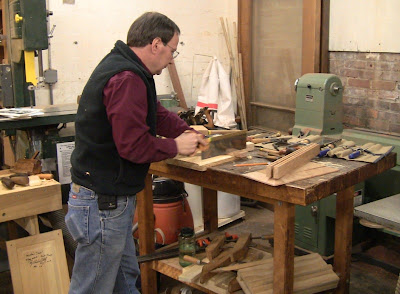
Sawing a tenon shoulder. Photo by Nick Roulleau.

My progress for the event: mortise and tenons and grooves cut into 1 rail and 2 stiles.

LN show staff, left to right, Tim Lovett, Ted Dishner, Deneb Puchalski, and Roger Benton.
Ted asked how the event had gone for me, and I told him I judge my success by how little I get done on my project. Small progress means I spent a lot of time talking to people, showing them things and letting them try the tools out. So this was definitely a success!
Labels:
Lie-Nielsen,
SAPFM
Subscribe to:
Posts (Atom)



